airbag TOYOTA YARIS 2013 Owner's Guide
[x] Cancel search | Manufacturer: TOYOTA, Model Year: 2013, Model line: YARIS, Model: TOYOTA YARIS 2013Pages: 712, PDF Size: 30.2 MB
Page 189 of 712
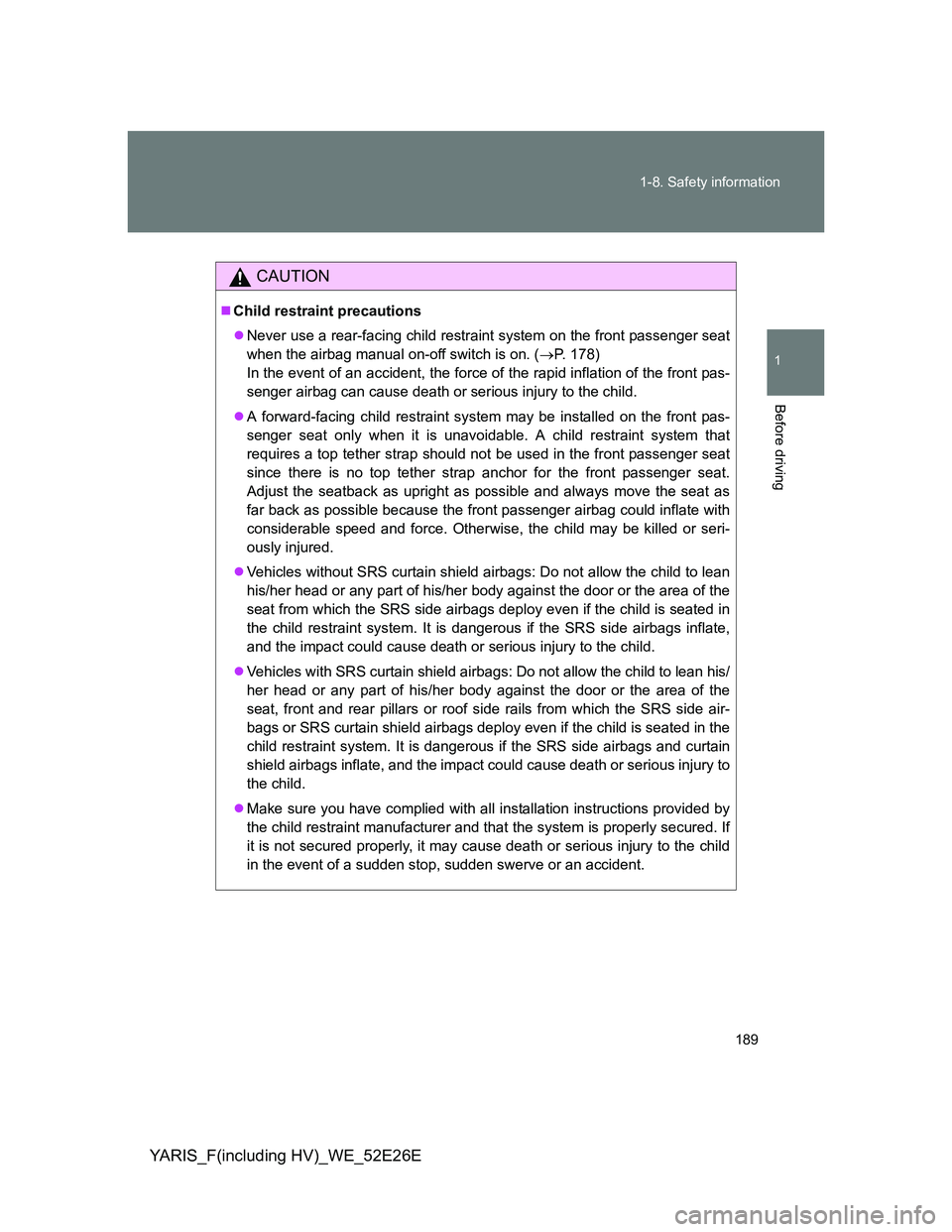
189 1-8. Safety information
1
Before driving
YARIS_F(including HV)_WE_52E26E
CAUTION
Child restraint precautions
Never use a rear-facing child restraint system on the front passenger seat
when the airbag manual on-off switch is on. (P. 178)
In the event of an accident, the force of the rapid inflation of the front pas-
senger airbag can cause death or serious injury to the child.
A forward-facing child restraint system may be installed on the front pas-
senger seat only when it is unavoidable. A child restraint system that
requires a top tether strap should not be used in the front passenger seat
since there is no top tether strap anchor for the front passenger seat.
Adjust the seatback as upright as possible and always move the seat as
far back as possible because the front passenger airbag could inflate with
considerable speed and force. Otherwise, the child may be killed or seri-
ously injured.
Vehicles without SRS curtain shield airbags: Do not allow the child to lean
his/her head or any part of his/her body against the door or the area of the
seat from which the SRS side airbags deploy even if the child is seated in
the child restraint system. It is dangerous if the SRS side airbags inflate,
and the impact could cause death or serious injury to the child.
Vehicles with SRS curtain shield airbags: Do not allow the child to lean his/
her head or any part of his/her body against the door or the area of the
seat, front and rear pillars or roof side rails from which the SRS side air-
bags or SRS curtain shield airbags deploy even if the child is seated in the
child restraint system. It is dangerous if the SRS side airbags and curtain
shield airbags inflate, and the impact could cause death or serious injury to
the child.
Make sure you have complied with all installation instructions provided by
the child restraint manufacturer and that the system is properly secured. If
it is not secured properly, it may cause death or serious injury to the child
in the event of a sudden stop, sudden swerve or an accident.
Page 197 of 712
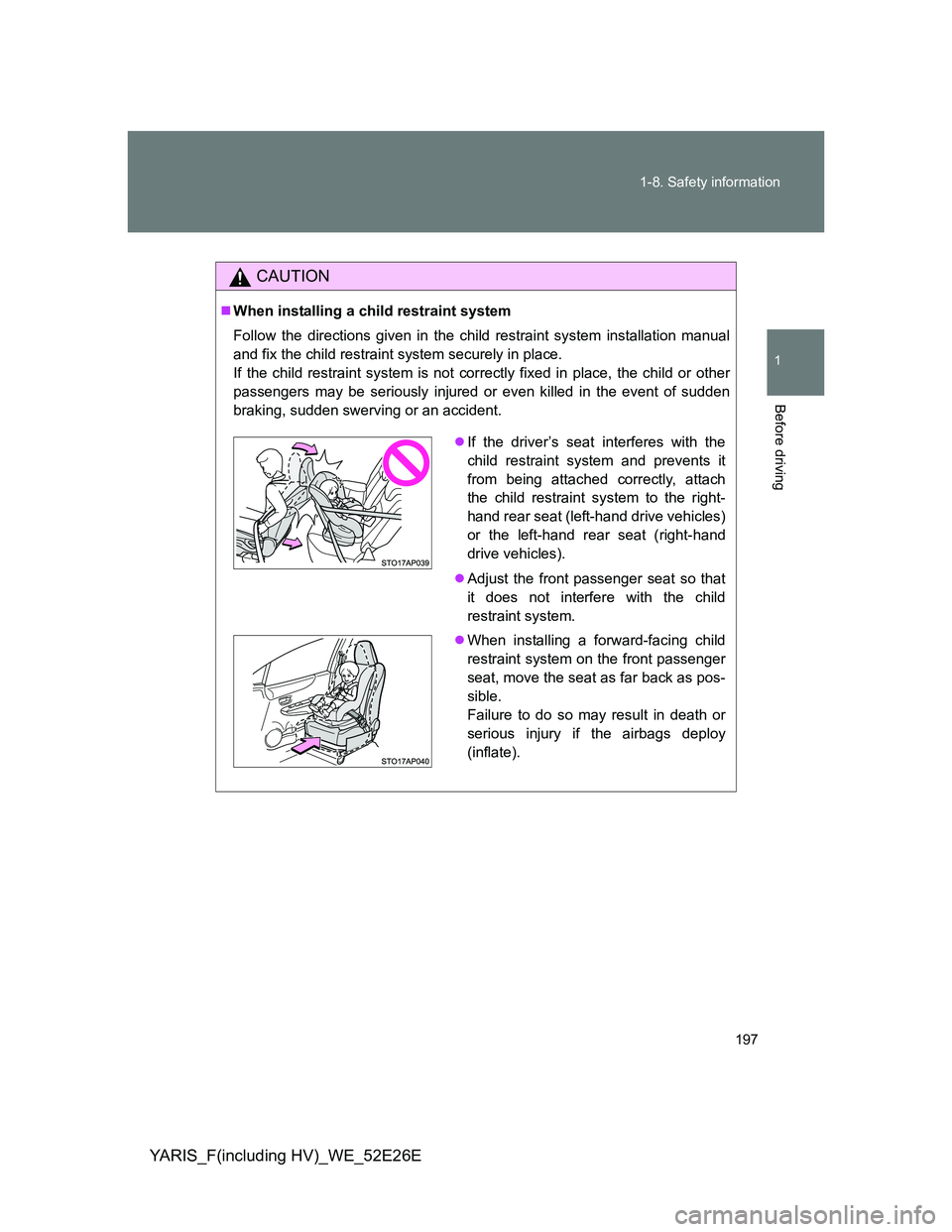
197 1-8. Safety information
1
Before driving
YARIS_F(including HV)_WE_52E26E
CAUTION
When installing a child restraint system
Follow the directions given in the child restraint system installation manual
and fix the child restraint system securely in place.
If the child restraint system is not correctly fixed in place, the child or other
passengers may be seriously injured or even killed in the event of sudden
braking, sudden swerving or an accident.
If the driver’s seat interferes with the
child restraint system and prevents it
from being attached correctly, attach
the child restraint system to the right-
hand rear seat (left-hand drive vehicles)
or the left-hand rear seat (right-hand
drive vehicles).
Adjust the front passenger seat so that
it does not interfere with the child
restraint system.
When installing a forward-facing child
restraint system on the front passenger
seat, move the seat as far back as pos-
sible.
Failure to do so may result in death or
serious injury if the airbags deploy
(inflate).
Page 198 of 712
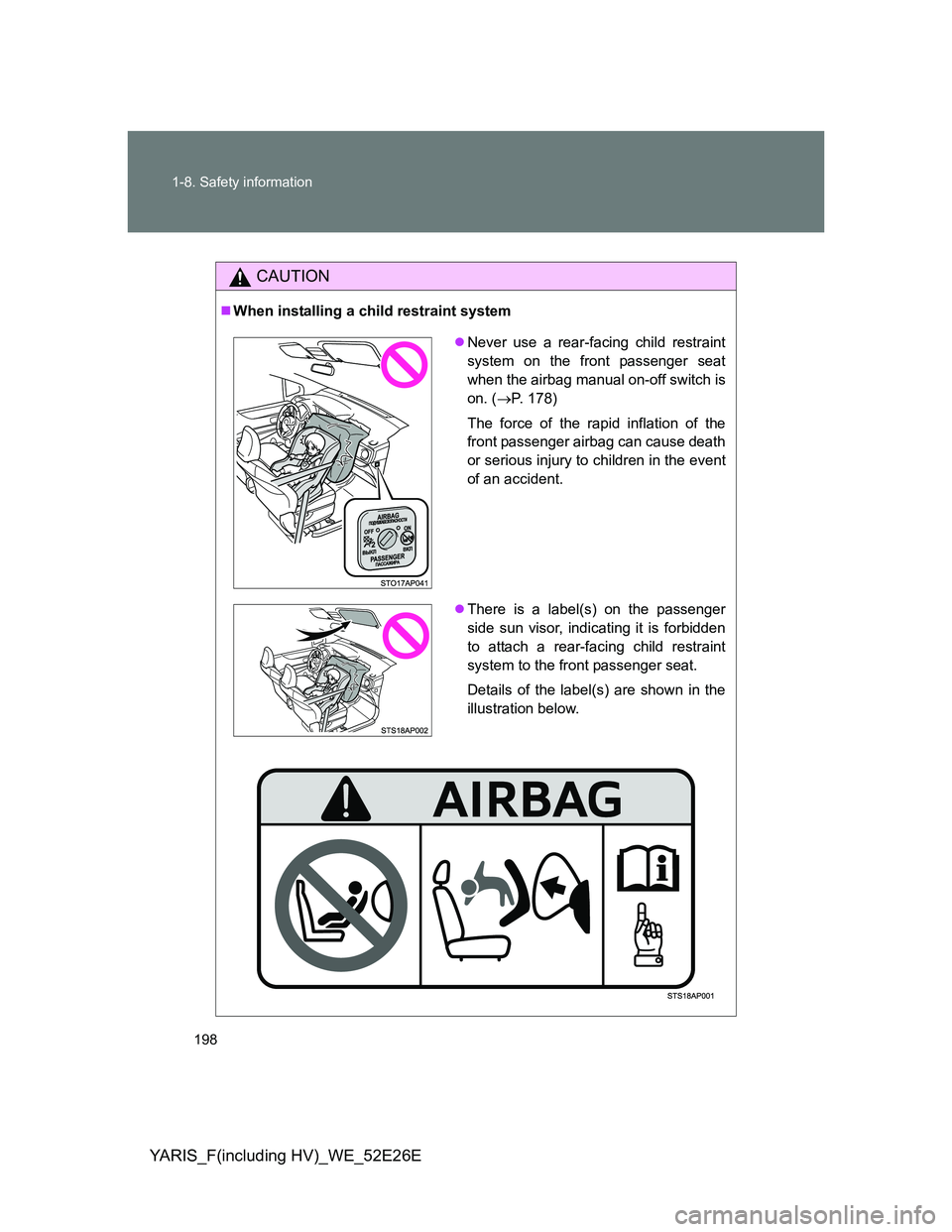
198 1-8. Safety information
YARIS_F(including HV)_WE_52E26E
CAUTION
When installing a child restraint system
Never use a rear-facing child restraint
system on the front passenger seat
when the airbag manual on-off switch is
on. (P. 178)
The force of the rapid inflation of the
front passenger airbag can cause death
or serious injury to children in the event
of an accident.
There is a label(s) on the passenger
side sun visor, indicating it is forbidden
to attach a rear-facing child restraint
system to the front passenger seat.
Details of the label(s) are shown in the
illustration below.
Page 450 of 712
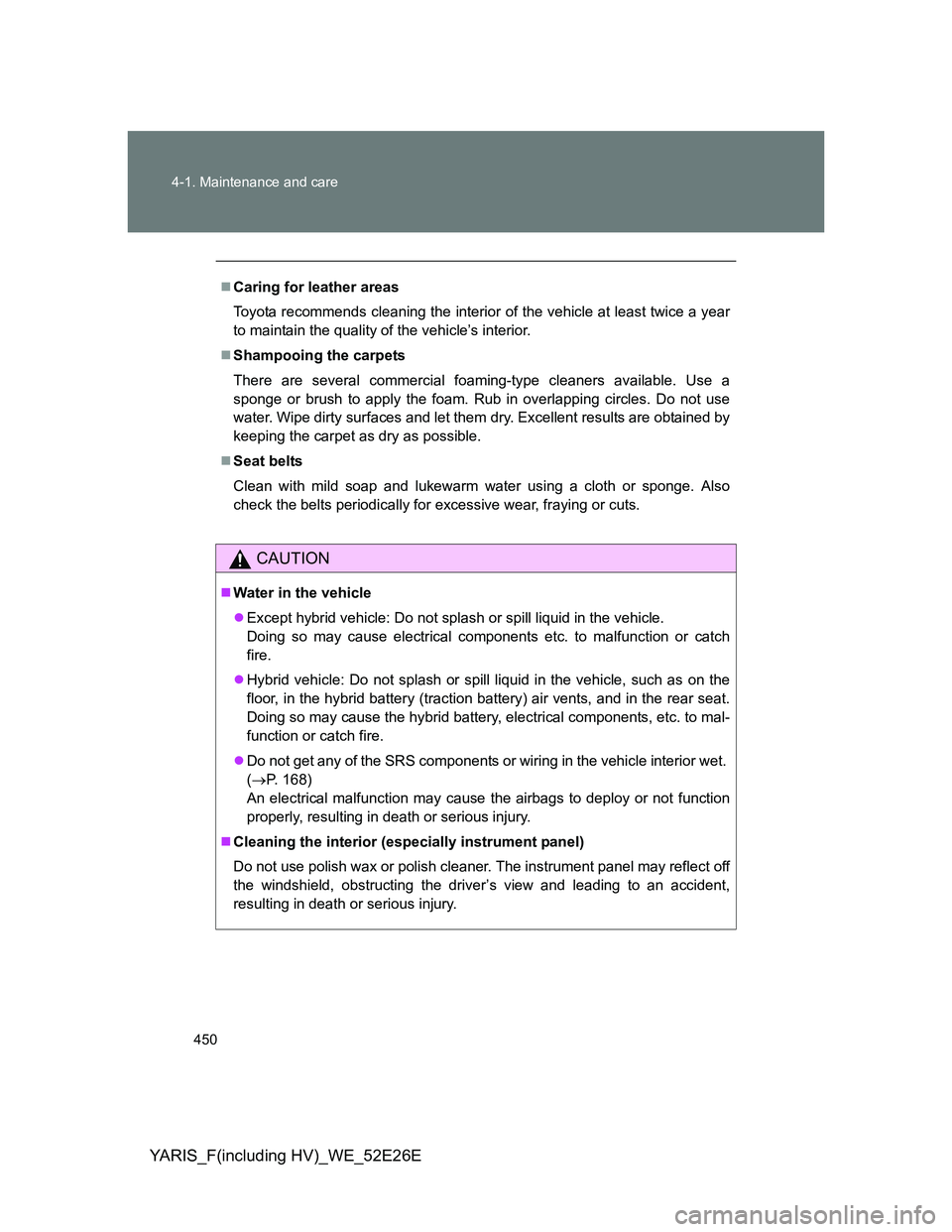
450 4-1. Maintenance and care
YARIS_F(including HV)_WE_52E26E
Caring for leather areas
Toyota recommends cleaning the interior of the vehicle at least twice a year
to maintain the quality of the vehicle’s interior.
Shampooing the carpets
There are several commercial foaming-type cleaners available. Use a
sponge or brush to apply the foam. Rub in overlapping circles. Do not use
water. Wipe dirty surfaces and let them dry. Excellent results are obtained by
keeping the carpet as dry as possible.
Seat belts
Clean with mild soap and lukewarm water using a cloth or sponge. Also
check the belts periodically for excessive wear, fraying or cuts.
CAUTION
Water in the vehicle
Except hybrid vehicle: Do not splash or spill liquid in the vehicle.
Doing so may cause electrical components etc. to malfunction or catch
fire.
Hybrid vehicle: Do not splash or spill liquid in the vehicle, such as on the
floor, in the hybrid battery (traction battery) air vents, and in the rear seat.
Doing so may cause the hybrid battery, electrical components, etc. to mal-
function or catch fire.
Do not get any of the SRS components or wiring in the vehicle interior wet.
(P. 168)
An electrical malfunction may cause the airbags to deploy or not function
properly, resulting in death or serious injury.
Cleaning the interior (especially instrument panel)
Do not use polish wax or polish cleaner. The instrument panel may reflect off
the windshield, obstructing the driver’s view and leading to an accident,
resulting in death or serious injury.
Page 516 of 712

516 4-3. Do-it-yourself maintenance
YARIS_F(including HV)_WE_52E26E
5IG2 10 ASmart entry & start system, multi-
port fuel injection system/sequen-
tial multiport fuel injection system,
multi-mode manual transmission,
SRS airbag system, steering lock
system, stop lights, Stop & Start
system
6IGN 15 AMultiport fuel injection system/
sequential multiport fuel injection
system
7MET 7.5 AGauge and meters, Stop & Start
system
8PWR HTR
*225 APower heater, multiport fuel injec-
tion system/sequential multiport
fuel injection system
9 EPS 50 A Electric power steering
10 ABS NO.2 30 A ABS, VSC
11 D E F 3 0 ARear window defogger, ID/UP,
MIR-HTR
12 SPARE 10 A Spare fuse
13 PTC 80 APTC heater, outside rear view mir-
ror defogger
14 HTR 40 A Air conditioning system
15 H-LP CLN 30 A
16 RDI FAN 30 A Electric cooling fan
17 ABS NO.1 50 A ABS, VSC
18 BBC
*340 A Stop & Start system
19 ST 30 A Starting system
20 AMP 15 A Audio system
21 D/L NO.2 25 A
Power door lock
22 D.C.C. 30 A DOME, ECU-B NO.1
FuseAmpereCircuit
Page 560 of 712
![TOYOTA YARIS 2013 Owners Guide 560
5-1. Essential information
YARIS_F(including HV)_WE_52E26E
Fuel pump shut off system (except hybrid vehicle [gasoline engine only])
Follow the procedure below to restart the engine after the syste TOYOTA YARIS 2013 Owners Guide 560
5-1. Essential information
YARIS_F(including HV)_WE_52E26E
Fuel pump shut off system (except hybrid vehicle [gasoline engine only])
Follow the procedure below to restart the engine after the syste](/img/14/49157/w960_49157-559.png)
560
5-1. Essential information
YARIS_F(including HV)_WE_52E26E
Fuel pump shut off system (except hybrid vehicle [gasoline engine only])
Follow the procedure below to restart the engine after the system is
activated.
Vehicles without a smart entry & start system:
Turn the engine switch to the “ACC” or “LOCK” position.
Restart the engine.
Vehicles with a smart entry & start system:
Turn the “ENGINE START STOP” switch to ACCESSORY mode
or turn it off.
Restart the engine.
NOTICE
Before starting the engine
Inspect the ground under the vehicle.
If you find that fuel has leaked onto the ground, the fuel system has been
damaged and is in need of repair. Do not restart the engine.
To minimize the risk of fuel leakage when the engine stalls or when
an airbag inflates upon collision, the fuel pump shut off system
stops the supply of fuel to the engine.
Page 564 of 712
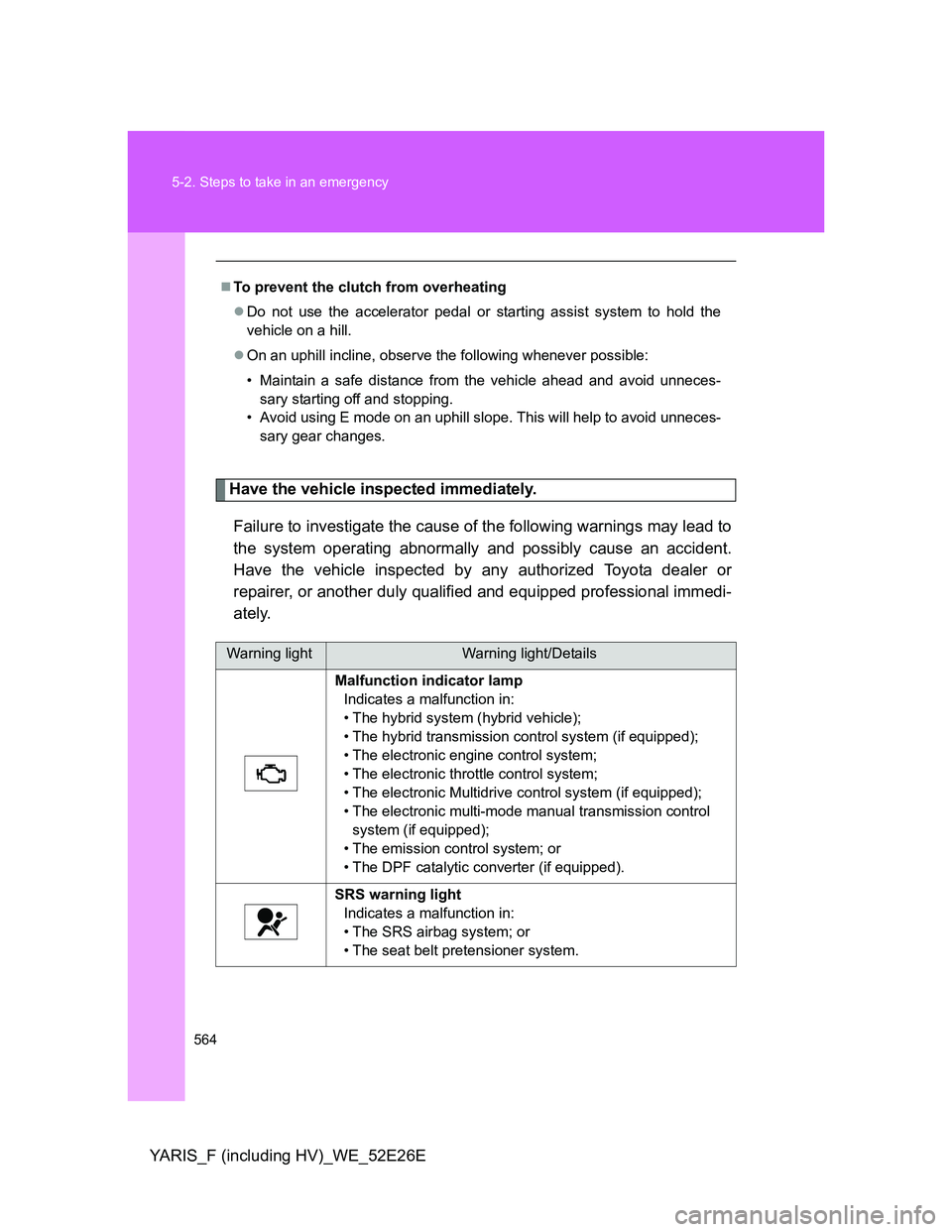
564 5-2. Steps to take in an emergency
YARIS_F (including HV)_WE_52E26E
Have the vehicle inspected immediately.
Failure to investigate the cause of the following warnings may lead to
the system operating abnormally and possibly cause an accident.
Have the vehicle inspected by any authorized Toyota dealer or
repairer, or another duly qualified and equipped professional immedi-
ately.
To prevent the clutch from overheating
Do not use the accelerator pedal or starting assist system to hold the
vehicle on a hill.
On an uphill incline, observe the following whenever possible:
• Maintain a safe distance from the vehicle ahead and avoid unneces-
sary starting off and stopping.
• Avoid using E mode on an uphill slope. This will help to avoid unneces-
sary gear changes.
Warning lightWarning light/Details
Malfunction indicator lamp
Indicates a malfunction in:
• The hybrid system (hybrid vehicle);
• The hybrid transmission control system (if equipped);
• The electronic engine control system;
• The electronic throttle control system;
• The electronic Multidrive control system (if equipped);
• The electronic multi-mode manual transmission control
system (if equipped);
• The emission control system; or
• The DPF catalytic converter (if equipped).
SRS warning light
Indicates a malfunction in:
• The SRS airbag system; or
• The seat belt pretensioner system.
Page 614 of 712
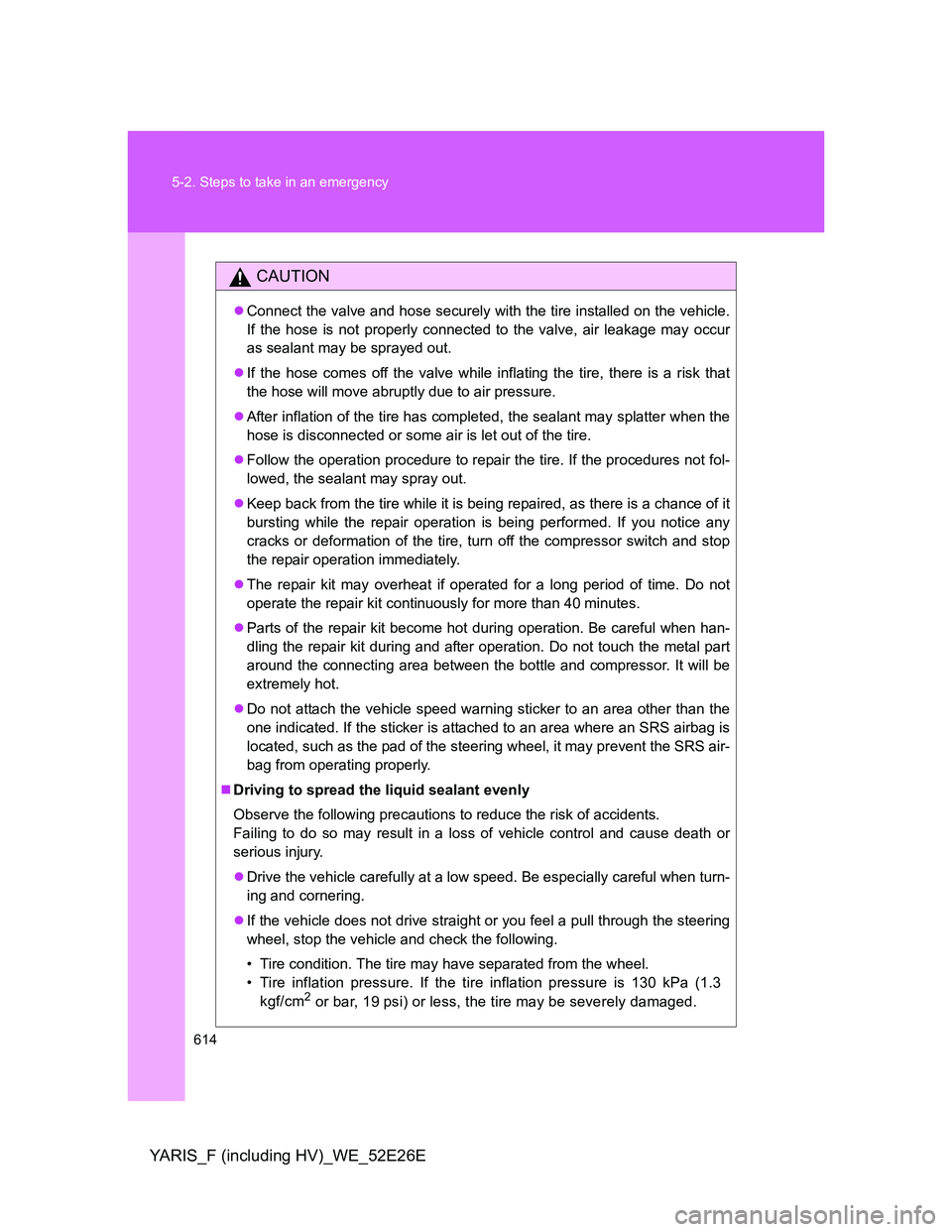
614 5-2. Steps to take in an emergency
YARIS_F (including HV)_WE_52E26E
CAUTION
Connect the valve and hose securely with the tire installed on the vehicle.
If the hose is not properly connected to the valve, air leakage may occur
as sealant may be sprayed out.
If the hose comes off the valve while inflating the tire, there is a risk that
the hose will move abruptly due to air pressure.
After inflation of the tire has completed, the sealant may splatter when the
hose is disconnected or some air is let out of the tire.
Follow the operation procedure to repair the tire. If the procedures not fol-
lowed, the sealant may spray out.
Keep back from the tire while it is being repaired, as there is a chance of it
bursting while the repair operation is being performed. If you notice any
cracks or deformation of the tire, turn off the compressor switch and stop
the repair operation immediately.
The repair kit may overheat if operated for a long period of time. Do not
operate the repair kit continuously for more than 40 minutes.
Parts of the repair kit become hot during operation. Be careful when han-
dling the repair kit during and after operation. Do not touch the metal part
around the connecting area between the bottle and compressor. It will be
extremely hot.
Do not attach the vehicle speed warning sticker to an area other than the
one indicated. If the sticker is attached to an area where an SRS airbag is
located, such as the pad of the steering wheel, it may prevent the SRS air-
bag from operating properly.
Driving to spread the liquid sealant evenly
Observe the following precautions to reduce the risk of accidents.
Failing to do so may result in a loss of vehicle control and cause death or
serious injury.
Drive the vehicle carefully at a low speed. Be especially careful when turn-
ing and cornering.
If the vehicle does not drive straight or you feel a pull through the steering
wheel, stop the vehicle and check the following.
• Tire condition. The tire may have separated from the wheel.
• Tire inflation pressure. If the tire inflation pressure is 130 kPa (1.3
kgf/cm
2 or bar, 19 psi) or less, the tire may be severely damaged.
Page 695 of 712
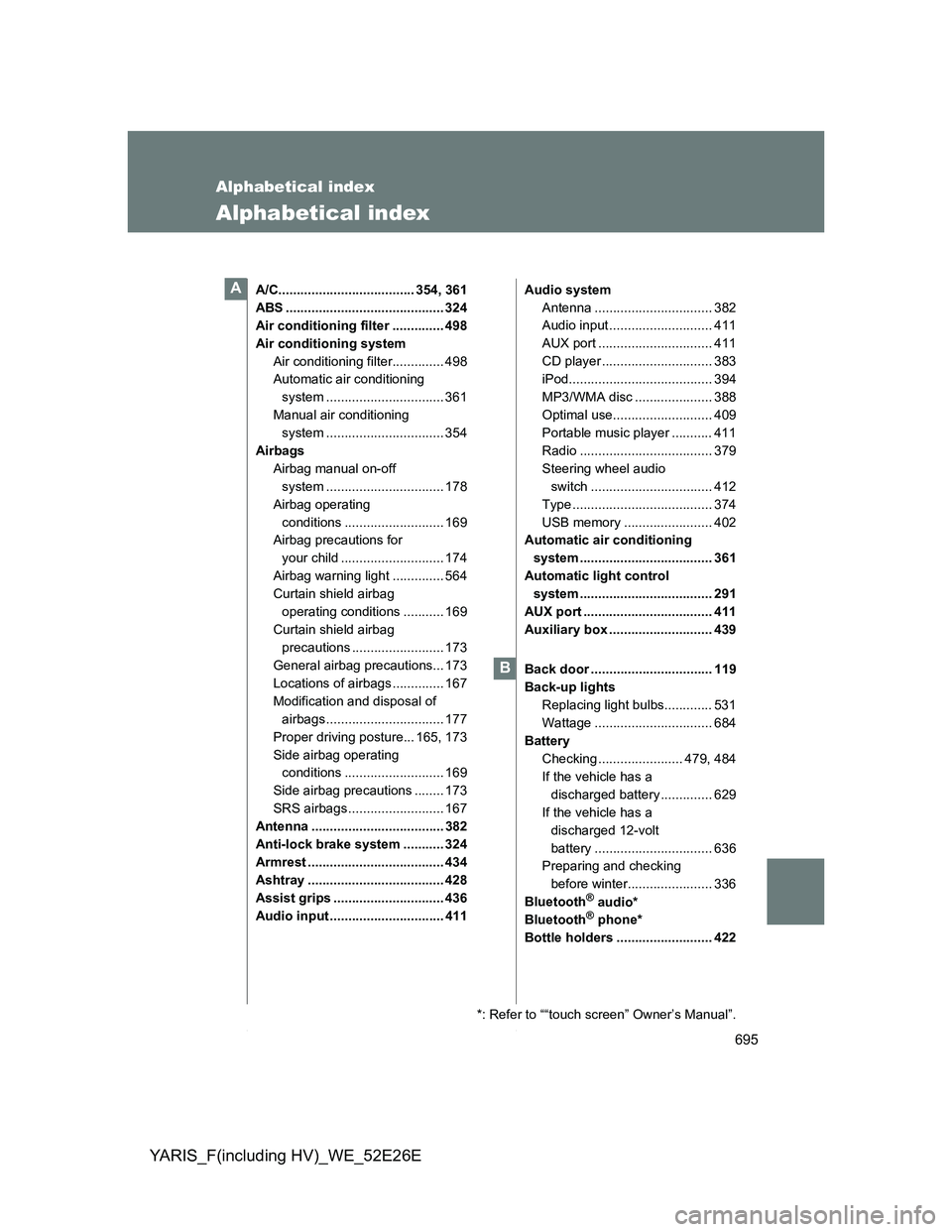
695
YARIS_F(including HV)_WE_52E26E
Alphabetical index
Alphabetical index
A/C..................................... 354, 361
ABS ........................................... 324
Air conditioning filter .............. 498
Air conditioning system
Air conditioning filter.............. 498
Automatic air conditioning
system ................................ 361
Manual air conditioning
system ................................ 354
Airbags
Airbag manual on-off
system ................................ 178
Airbag operating
conditions ........................... 169
Airbag precautions for
your child ............................ 174
Airbag warning light .............. 564
Curtain shield airbag
operating conditions ........... 169
Curtain shield airbag
precautions ......................... 173
General airbag precautions... 173
Locations of airbags .............. 167
Modification and disposal of
airbags ................................ 177
Proper driving posture... 165, 173
Side airbag operating
conditions ........................... 169
Side airbag precautions ........ 173
SRS airbags .......................... 167
Antenna .................................... 382
Anti-lock brake system ........... 324
Armrest ..................................... 434
Ashtray ..................................... 428
Assist grips .............................. 436
Audio input ............................... 411Audio system
Antenna ................................ 382
Audio input ............................ 411
AUX port ............................... 411
CD player .............................. 383
iPod....................................... 394
MP3/WMA disc ..................... 388
Optimal use........................... 409
Portable music player ........... 411
Radio .................................... 379
Steering wheel audio
switch ................................. 412
Type ...................................... 374
USB memory ........................ 402
Automatic air conditioning
system .................................... 361
Automatic light control
system .................................... 291
AUX port ................................... 411
Auxiliary box ............................ 439
Back door ................................. 119
Back-up lights
Replacing light bulbs............. 531
Wattage ................................ 684
Battery
Checking ....................... 479, 484
If the vehicle has a
discharged battery .............. 629
If the vehicle has a
discharged 12-volt
battery ................................ 636
Preparing and checking
before winter....................... 336
Bluetooth
® audio*
Bluetooth® phone*
Bottle holders .......................... 422
A
B
*: Refer to ““touch screen” Owner’s Manual”.
Page 696 of 712
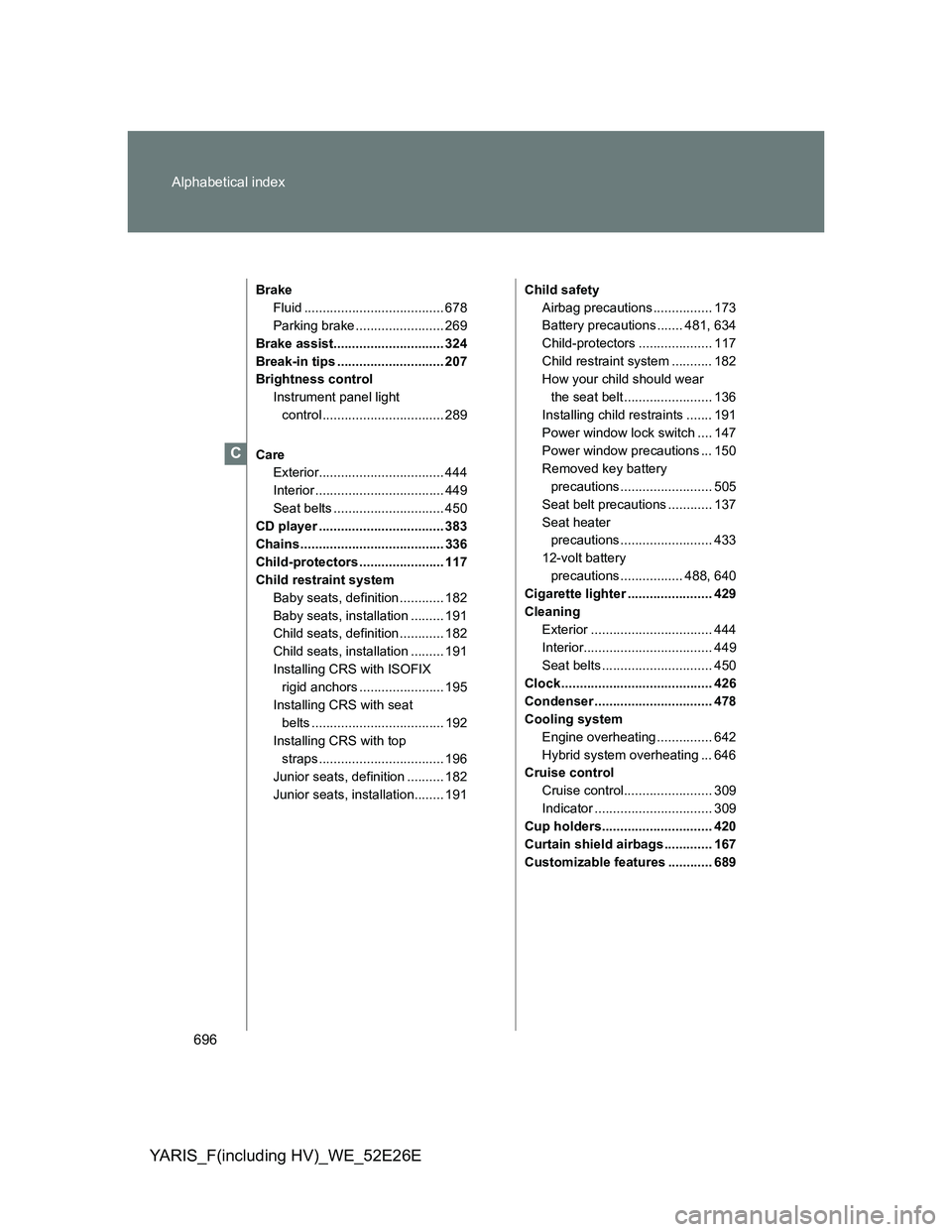
696 Alphabetical index
YARIS_F(including HV)_WE_52E26E
Brake
Fluid ...................................... 678
Parking brake ........................ 269
Brake assist.............................. 324
Break-in tips ............................. 207
Brightness control
Instrument panel light
control ................................. 289
Care
Exterior.................................. 444
Interior ................................... 449
Seat belts .............................. 450
CD player .................................. 383
Chains ....................................... 336
Child-protectors ....................... 117
Child restraint system
Baby seats, definition ............ 182
Baby seats, installation ......... 191
Child seats, definition ............ 182
Child seats, installation ......... 191
Installing CRS with ISOFIX
rigid anchors ....................... 195
Installing CRS with seat
belts .................................... 192
Installing CRS with top
straps .................................. 196
Junior seats, definition .......... 182
Junior seats, installation........ 191Child safety
Airbag precautions ................ 173
Battery precautions ....... 481, 634
Child-protectors .................... 117
Child restraint system ........... 182
How your child should wear
the seat belt ........................ 136
Installing child restraints ....... 191
Power window lock switch .... 147
Power window precautions ... 150
Removed key battery
precautions ......................... 505
Seat belt precautions ............ 137
Seat heater
precautions ......................... 433
12-volt battery
precautions ................. 488, 640
Cigarette lighter ....................... 429
Cleaning
Exterior ................................. 444
Interior................................... 449
Seat belts .............................. 450
Clock ......................................... 426
Condenser ................................ 478
Cooling system
Engine overheating ............... 642
Hybrid system overheating ... 646
Cruise control
Cruise control........................ 309
Indicator ................................ 309
Cup holders.............................. 420
Curtain shield airbags ............. 167
Customizable features ............ 689
C